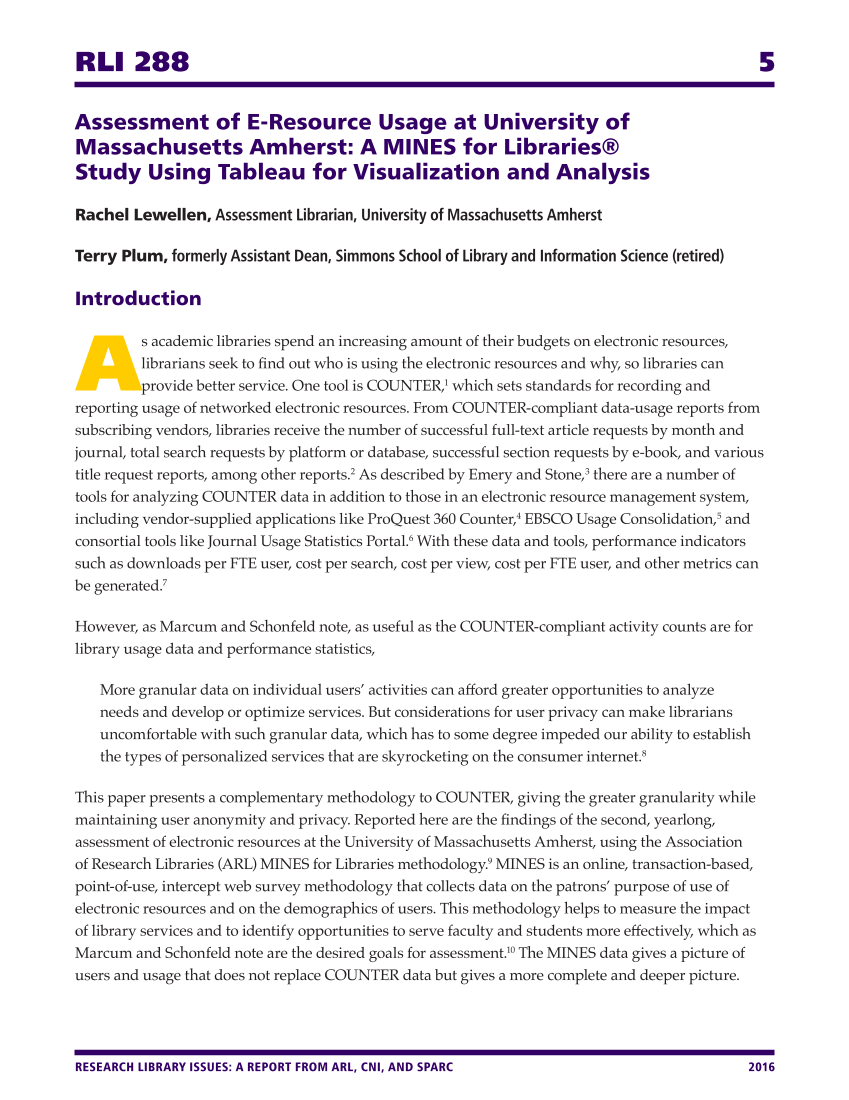RLI 288 5 RESEARCH LIBRARY ISSUES: A REPORT FROM ARL, CNI, AND SPARC 2016 Assessment of E-Resource Usage at University of Massachusetts Amherst: A MINES for Libraries® Study Using Tableau for Visualization and Analysis Rachel Lewellen, Assessment Librarian, University of Massachusetts Amherst Terry Plum, formerly Assistant Dean, Simmons School of Library and Information Science (retired) Introduction A s academic libraries spend an increasing amount of their budgets on electronic resources, librarians seek to find out who is using the electronic resources and why, so libraries can provide better service. One tool is COUNTER,1 which sets standards for recording and reporting usage of networked electronic resources. From COUNTER-compliant data-usage reports from subscribing vendors, libraries receive the number of successful full-text article requests by month and journal, total search requests by platform or database, successful section requests by e-book, and various title request reports, among other reports.2 As described by Emery and Stone,3 there are a number of tools for analyzing COUNTER data in addition to those in an electronic resource management system, including vendor-supplied applications like ProQuest 360 Counter,4 EBSCO Usage Consolidation,5 and consortial tools like Journal Usage Statistics Portal.6 With these data and tools, performance indicators such as downloads per FTE user, cost per search, cost per view, cost per FTE user, and other metrics can be generated.7 However, as Marcum and Schonfeld note, as useful as the COUNTER-compliant activity counts are for library usage data and performance statistics, More granular data on individual users’ activities can afford greater opportunities to analyze needs and develop or optimize services. But considerations for user privacy can make librarians uncomfortable with such granular data, which has to some degree impeded our ability to establish the types of personalized services that are skyrocketing on the consumer internet.8 This paper presents a complementary methodology to COUNTER, giving the greater granularity while maintaining user anonymity and privacy. Reported here are the findings of the second, yearlong, assessment of electronic resources at the University of Massachusetts Amherst, using the Association of Research Libraries (ARL) MINES for Libraries methodology.9 MINES is an online, transaction-based, point-of-use, intercept web survey methodology that collects data on the patrons’ purpose of use of electronic resources and on the demographics of users. This methodology helps to measure the impact of library services and to identify opportunities to serve faculty and students more effectively, which as Marcum and Schonfeld note are the desired goals for assessment.10 The MINES data gives a picture of users and usage that does not replace COUNTER data but gives a more complete and deeper picture.





































